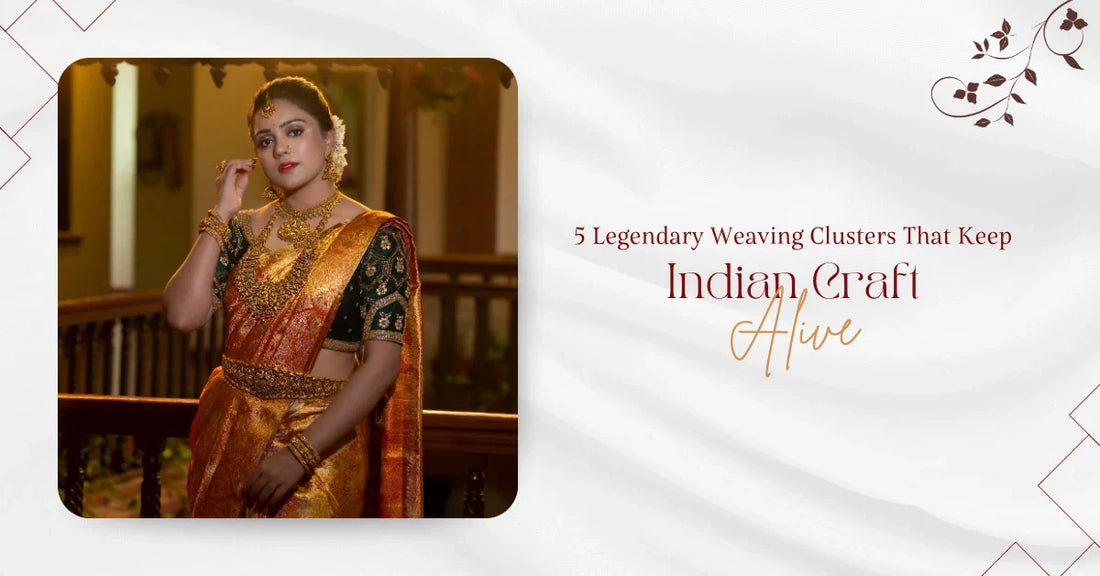5 Legendary Weaving Clusters That Keep Indian Craft Alive
Introduction
India’s heritage is woven — not written — in threads of silk, cotton, and gold. For centuries, master weavers across the country have kept alive a tradition that celebrates artistry, patience, and cultural pride. Each region has its own story, its own rhythm on the loom, and its own masterpiece that defines its identity. These weaving clusters are not just centers of textile production; they are living museums of India’s soul. From the royal looms of Kanchipuram to the delicate artistry of Banaras, these regions continue to nurture India’s heritage of handloom excellence. Let’s journey through five legendary weaving clusters of India that continue to define luxury, tradition, and timeless grace.
1. Kanchipuram, Tamil Nadu – The Temple Town of Silk
Known as the “City of Thousand Temples,” Kanchipuram has been weaving its magic for centuries. The sarees born here are famed for their lustrous texture, contrasting borders, and motifs inspired by temple architecture — gopurams, peacocks, and lotuses.
The process is entirely hand-woven, with pure mulberry silk threads interlaced with real zari. A single saree can take weeks to craft, and no two pieces are ever identical.
Today, Kanchipuram sarees remain an integral part of South Indian weddings and celebrations, symbolizing prosperity, devotion, and heritage.
- Fun fact: Kanchipuram sarees are so durable that they are often passed down as heirlooms for generations.
2. Varanasi, Uttar Pradesh – The Golden Legacy of Banarasi Weaves
In the heart of North India lies Varanasi, home to the world-famous Banarasi saree. Introduced during the Mughal era, this weave fuses Persian motifs with Indian artistry — think intricate floral patterns, lattice work, and gold or silver zari detailing.
Each Banarasi saree is a masterpiece of patience: artisans often take 15 to 30 days to complete a single piece.
From royal brides to modern fashion icons, Banarasi silk continues to symbolize opulence and grace.
Tip: A genuine Banarasi saree is heavier than it looks, thanks to its dense zari and silk threads.
3. Pochampally, Telangana – The Geometry of Ikat
Pochampally, located near Hyderabad, is celebrated for its distinctive Ikat weaving — a technique where threads are tie-dyed before weaving to create sharp, geometric patterns.
Known as the “Silk City of India,” Pochampally’s designs combine tradition with modern aesthetics, making them globally popular.
Each saree showcases mathematical precision and artistic imagination, a testament to the community’s creativity and discipline.
Did you know? Pochampally Ikat received the Geographical Indication (GI) tag in 2005, officially recognizing its heritage value.
4. Assam – The Golden Glow of Muga and Eri Silk
Assam’s handloom tradition is as serene as its landscapes. The region is renowned for its Muga silk, often called “the golden silk of Assam,” and Eri silk, known for its soft texture and eco-friendly production.
Muga silk has a natural golden hue that never fades, while Eri silk — also known as the “peace silk” — is produced without harming the silkworm.
These silks are integral to Assamese culture, worn during festivals like Bihu and traditional ceremonies.
Eco insight: Assam’s silks are 100% natural, biodegradable, and sustainable — proof that heritage can be kind to nature.
5. Bhagalpur, Bihar – The City of Tussar Silk
Bhagalpur, often called the “Silk City of Bihar,” is celebrated for its Tussar silk, a fabric that glows with an understated golden hue.
What makes Tussar special is its rich texture, lightness, and ability to drape beautifully in all climates.
The local artisans of Bhagalpur use vegetable dyes and traditional looms, keeping ancient weaving practices alive while appealing to global sensibilities.
Tradition meets trend: Tussar silk’s raw charm is now being rediscovered in designer collections across the world.
How These Clusters Sustain Heritage and Livelihood
These five clusters represent more than fabric — they embody resilience.
Despite modernization, thousands of families continue to rely on handloom weaving as their main livelihood. Organizations and brands like Sri Krishna Silks work closely with these artisans, ensuring fair trade, sustainable sourcing, and the preservation of traditional techniques.
Each saree purchased supports not just a craft, but a community’s future.
Reviving Tradition in Modern Fashion
Indian handlooms are finding new relevance in the global fashion scene. Designers are reinterpreting traditional motifs into contemporary silhouettes, while mindful buyers are embracing heritage weaves over fast fashion.
Sri Krishna Silks continues this revival by curating collections that honor the past while celebrating modern womanhood — elegant, empowered, and rooted in tradition.
Conclusion
From the looms of Kanchipuram to the silken threads of Assam, India’s weaving clusters are the heartbeat of our cultural identity. Each cluster tells a story — of devotion, artistry, and legacy that endures through changing times. These handwoven treasures remind us that heritage isn’t confined to museums; it lives in every saree we drape.
Explore the world of authentic weaves at Sri Krishna Silks — where every thread celebrates India’s timeless craft and the artisans who keep it alive.



